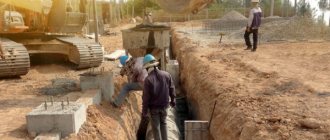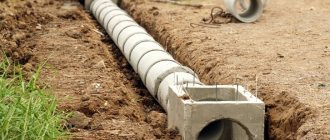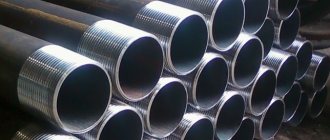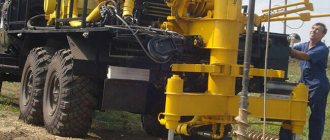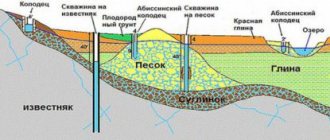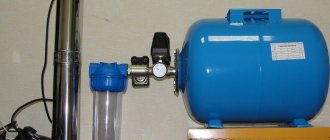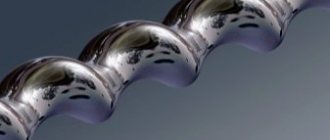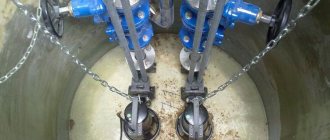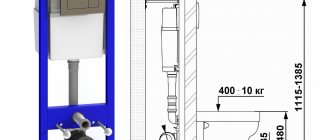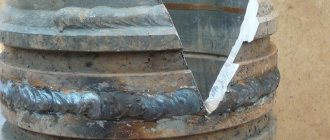Content
6 types of casing
What is casing pipe needed for?
How does a single-pipe design differ from a two-pipe design?
How to choose casing pipe material?
Types of casing
The casing material depends on the purpose of drilling, as well as the operating conditions of the well, climatic features and the depth of the aquifers. It is impossible to say with absolute certainty that metal is better than plastic and vice versa; each type of casing pipes has pros and cons.
works with 6 types of casing:
Well drilling diameter: why is it important ↑
The well diameter refers to the internal size of the production string into which pumping equipment, water-lifting pipelines and other equipment are lowered. In this case, direct drilling of the soil is carried out with a larger drill, especially when constructing a two-column borehole structure.
Interesting to know. Drilling in two columns is carried out if other horizons are located above the main aquifer. In this case, the external casing (conductor) protects the main horizon from the penetration of water from upper sources, and the production casing located inside organizes water intake.
Construction of a well with two columns
From the point of view of productivity and maintenance, a high pipe diameter for the well is more preferable. Firstly, the volume of the filter zone increases, which means that with the same capacity of the water carrier, more water can be pumped out per unit of time (although the flow rate of the source remains the fundamental parameter). Secondly, it becomes possible to use larger (and more powerful) equipment, and the process of repair and maintenance of the structure is significantly simplified.
On the other hand: large diameter means high price. When the drilling width doubles, the cost of work almost triples. Therefore, it is very important to make the calculation in such a way as to satisfy both financial and consumer needs.
What is casing pipe needed for?
- "Skeleton" of the well.
The outer walls of the well are the casing pipe; how strong they will be depends only on it. - Protection.
Protects against the collapse of the earth into the well space, against the ingress of wastewater from the top layer of soil, from groundwater, as well as all kinds of pollution. - Quality.
The quality of the resulting water also depends on the casing. For example, metal, in contact with water, will be subject to corrosion; over time, there will be more and more small particles of rust in the resulting liquid. This water should not be drunk.
- To ensure that the well is worth the money spent and meets your goals and expectations, you must choose the correct casing diameter and design.
Features of pipes for wells made of ferrous metal
Ferrous metal, as a material for the manufacture of casing pipes, is very popular when drilling water wells. A casing with a wall thickness of over 6 mm is classified as an eternal material, so the well can function flawlessly for half a century.
The use of such material makes the life of the well and the aquifer the same.
The steel used to make casing pipes has some features that you need to know to fully understand wells of this type:
- Steel is an environmentally friendly material, so its contact with water is not accompanied by the release of chemicals. Rust that forms on metal surfaces does not dissolve in water and does not increase iron levels, as many people believe. Rust is removed by passing water through a regular household filter (more details: “How to choose a filter for a water pipe - an overview of possible options, pros and cons”).
- High strength characteristics and impact strength prevent the formation of defects or destruction of the casing pipe during installation or operation.
- Clogging or silting of the well, as well as accidental entry of foreign objects, is eliminated by additional drilling or performing other work using drilling tools.
- Steel casing makes it possible to drill wells even if the aquifer lies very deep.
With such positive characteristics, the high price of the material, which is considered its main negative quality, becomes less relevant. The main thing is to correctly calculate the operating period for the well.
How does a single-pipe design differ from a two-pipe design?
Monotube design
During the drilling process, casing is carried out only up to the limestone; further along the limestone there remains a bare trunk.
Twin-pipe design
The casing process is exactly the same, only an additional plastic pipe is installed along the entire length of the well. The plastic is perforated, which allows water to pass through, but does not allow particles of tumbled limestone to pass through, thereby protecting your pump from premature failure. In addition, the plastic prevents the limestone from collapsing, which extends the life of the well.
The water is in plastic and does not come into contact with metal, this allows it to remain in the original form in which nature gives us.
What to choose?
Steel casing pipes in accordance with GOST 632-80 and couplings for them
Steel casing is the most popular solution and meets all requirements in many respects. Its durability reaches 50 years or more, it can withstand high pressures, including pressure during the movement of layers, and does not release harmful substances into the water. The only drawback of black steel columns is the formation of rust, but modern filters perfectly solve this problem. In addition, metal pipes made of steel are easy to clean when silting occurs.
However, the high cost of steel casing pipes makes them economically unprofitable when drilling in sand. Although they are indispensable for the construction of artesian well systems, they are economically justified, and they are recommended to be used - the service life of steel columns reaches the service life of the well system itself.
Download in PDF GOST 632-80 Casing pipes and couplings for them.
Asbestos cement pipes
Advantages of asbestos-cement products:
- chemical resistance - pipes do not interact with most chemically active compounds;
- no threat of installation corrosion;
- low cost of products, comparable to plastic pipes and significantly lower than similar steel products.
Disadvantages of asbestos cement:
- high fragility - because of this factor, it is necessary to use pipes with increased wall thickness, which increases the weight of the products and complicates installation;
- the material cannot be used in the construction of filter columns; Such pipes are ideally suited for wells in limestone environments with a depth of about 100 m.
What type of pipes should I choose: pressure or non-pressure?
To decide which type of pipes to give preference to, first find out what they are:
- Gravity pipes are pipes that are used in conditions without pressure.
- Pressure is a material whose walls can withstand high external and internal pressure.
Important! To construct casing columns, purchase only pressure pipes, since soil pressure on the internal walls of the structure is inevitable.
Polymer pipes
Recently, these products have become increasingly popular.
Advantages of plastic pipes:
- Quite a long service life, provided careful installation and operation of the product;
- chemical neutrality of products - plastic does not react with most aggressive environments that threaten the well and is not subject to corrosion;
- no need to install additional rust filters (in connection with the previous point);
- products have significantly less weight than metal ones, which facilitates the assembly of the structure, maintenance and replacement of elements;
- such pipes are relatively inexpensive;
- a large standard-size range of manufactured products, making it possible to select pipes with the required parameters for each well;
- the ability to use pipes when constructing wells of any type and size, although they are most often used when drilling tunnels in a sandy environment with a depth of about 50-60 m;
- ideal for constructing filter columns.
Disadvantages of the product:
- low resistance to mechanical stress, as a result of which pipes must be installed carefully, avoiding damage to the surface; in addition, when exposed to aggressive external factors, damage to the well is possible;
- inability to clear the silted area using drilling rigs.
How to introduce water into a house from a well - HDPE pipe thickness
Taking into account average and peak water consumption for a country house, the optimal diameter is 32 mm, providing sufficient throughput
I always make an individual calculation for each individual customer, and the calculations are based on the following indicators:
- Total number of consumers - number of people living in the house
- Total number of water intake points and their maximum peak consumption
- Loss of throughput in the water treatment area - filtration systems
- Supply pipe length (the longer, the larger diameter required)
- Reserve for the possibility of connecting additional water consumption points later
- Type of pumping equipment
As a result, I get the value of peak water consumption, provided that all plumbing fixtures and equipment are turned on simultaneously. For all of them to work correctly, the pipe must provide a throughput greater than this value.
Water pipe – diameter 32 mm.
The throughput of a pipe depends on its internal diameter. Let me give you a few meanings so you can get your bearings:
- 25 mm – 750 liters per hour
- 32 mm – 1620 liters per hour
- 40 mm – 2500 liters per hour
- 50 mm – 4700 liters per hour
I don’t see any point in giving values for pipes of larger diameter, because the flow rate of domestic wells rarely exceeds 5 tons per hour, and consumption in a private home is much less. The optimal diameter of the supply pipe is 40-50 mm.
What is the best way to connect pipes when drilling a well?
If the well diameter is more than 10 cm and a submersible pump is supposed to be installed, then the casing pipe will consist of segments, the length of which is usually 3-12 meters.
Important! To understand which connection method to choose, remember that the main job of the casing is to maintain a tight seal.
There are 3 connection methods:
- Threaded connections, including fittings. This method is considered the most expensive due to its high degree of reliability. To ensure a good seal, a threaded pipe for the well will be the most reasonable solution. But keep in mind that when using fittings, the internal useful diameter of the well may decrease, which will also limit the choice of pump.
- Welding connection method. A questionable way to design joints, since the tightness of the welding seams will directly depend on the work of the welder. Also take into account that welds on metal pipes are subject to corrosion, which significantly reduces service life. It is considered more acceptable to use such technology for constructing pipelines in open areas in order to promptly detect destruction and stop it, preventing an emergency.
- Socket fitting is a method of connecting pipes using an O-ring. This method is absolutely unreliable, since you will not be able to control the quality of pipe installation, and there is also a possibility of subsidence during use.
Important! From all of the above, it is easy to conclude in favor of the only correct connection technology when arranging a drill well - connecting pipes with threads.
Pipe for a well 110 or 160 mm?
For shallow wells, 110 mm is enough, and for deep artesian wells, I recommend using a pipe of 133-160 mm.
The diameter of the pipe is important only when drilling and constructing deep wells - from 20 meters or more. If drilling is carried out in sand, and the depth of the aquifer is 10-15 meters, then the diameter of the pipe will not matter at all - the wall thickness is more important, the larger it is, the better.
Standard diameters of pipes made of different materials.
When drilling deep wells, it is definitely better to give preference to pipes of larger diameter. Firstly, you will be able to use a wider range of pumping equipment and set up a supply system without any problems. Secondly, you will have a reserve diameter in case there is a need to deepen the hydraulic structure.
The price of one linear meter of a pipe made of food-grade HDPE with a thread with a diameter of 110 mm will be about 300 rubles, with a diameter of 160 mm - 600 rubles. The difference is noticeable, so I advise you to install a larger diameter pipe only in wells with a depth of 20-25 meters or more.
What pipe diameter should I choose for the well?
The diameter of the casing pipe is calculated depending on the type of pump used. Moreover, if the water pump horizon on the territory of the house has an increased dynamic and statistical water level, then the pump in the casing pipe is in a suspended state.
Important! It is better to clarify information on these indicators with organizations that drill wells.
To understand how to make the calculation correctly, we suggest considering the option for a building where the water flow rate is approximately 3 m3/hour. A pump with a diameter of 75 mm is suitable for these purposes.
To calculate the diameter of the pipe, carry out the following calculations: 75 mm + 8 mm (pipe wall thickness) + 4 mm (gap between the pipe and the pump) = 87 mm.
Important! All casing pipes have standard sizes. The following standard casing pipe diameter sizes are most suitable for the resulting figure:
- 114 mm;
- 109 mm;
- 89 mm.
For a pump with a diameter of 102 mm, the calculation is carried out using the same method: 102 + 8 + 4 = 114 - this is a suitable pipe diameter, but it is better to choose with a margin - 127-133 mm.
Important! The best option is steel pipes with an internal diameter of 10-15 cm, as well as PVC pipes with a diameter of 75-140 mm. Such pipes are not removed from wells.
uPVC
When choosing pipes for a water well, it is impossible to ignore plastic products. The best among them are PVC-U casing pipes. Thanks to the properties of this material, their internal surfaces are of high quality. This reduces resistance to water flow and makes it possible to reduce the diameter of the pipelines used. The duration of operation does not affect the throughput of the products and their hydraulic resistance. Unplasticized polyvinyl chloride does not adversely affect the taste and smell of water. Columns made from it are very durable, they help extend the overall life of the structure to 80 years . Such high performance characteristics allow them to be safely used in artesian wells.
Types of pipe materials for wells
Borehole pipes are made of metal, asbestos cement or plastic. Very rarely, when organizing water intake, wooden products are used - they are absolutely environmentally friendly, but, despite the protective treatment, they are susceptible to soil moisture and are prone to deformation.
Metal
Metal supply pipes are available in two versions:
- cast iron;
- steel, which can be enameled, galvanized, made of stainless steel.
Very rarely cast iron analogues are used for casing. Among their metal counterparts, these pipes are the most affordable, but the material is very fragile and heavy.
Many companies refuse to work with cast iron due to installation difficulties. In addition, it is impossible to guarantee the safety and tightness of the pipe - when the soil layer moves, the metal can crack
Steel is a traditional, decades-tested material for casing. The steel almost 100% meets the requirements for well pipes.
Products made of ferrous metal adequately withstand testing in wells of different depths, regardless of the type of soil.
The standard wall thickness is 5-6 mm, the service life is about 50 years. Durability is determined by the corrosion rate of the steel sheet - 0.1 mm per year
Arguments in favor of rolled steel pipes:
- structural rigidity - the material is equally good for small wells (50 m) and for deep drilling (up to 300 m);
- precise axial alignment of the assembly and reliability of inter-pipe joints;
- stability of the material – when in contact with water, steel does not emit harmful substances;
- possibility of maintenance - due to the mechanical strength and resistance to vibration in the installed casing, cleaning of the well channel and additional drilling in case of silting or clogging is permissible.
The main disadvantage of steel mains is the high cost of the material. Manufacturers of cheaper analogues, extolling their products, appeal to another disadvantage of steel - the formation of rust.
There is an opinion that the resulting pollution worsens the quality of water and increases the iron content in it. However, tests of well water show that this is a myth.
Rust is insoluble in water. Even a household filter can retain oxidized metal particles. A possible problem due to rust is the breakdown of pumping equipment designed to pump clean water
Rolled metal with corrosion protection is more expensive than conventional steel pipes, but the technical and operational features of the materials cast doubt on the advisability of overpaying.
Enameled pipes. The coating prevents corrosion, but it is very fragile and it is unlikely to be able to avoid damage during casing. Places of chips and microcracks in enamel are points where rust appears.
During the destruction process, through corrosion may form in the damaged area, since thinner metal is used in the production of enameled pipes.
The enameled pipeline meets all sanitary and hygienic standards and does not change the taste of the water. The disadvantage of the material is the impossibility of fully cleaning the line due to the fragility of the enamel
Galvanized pipeline. With regular contact with water, zinc oxide is formed on the walls of the pipe - a substance hazardous to health. The use of galvanizing is permissible only when constructing a technical well.
The standard thickness of a galvanized pipe is 2-2.5 mm - this is not always enough to ensure structural rigidity. Such a highway is subject to deformation due to soil movements
Stainless steel. The material has all the advantages of rolled steel and an even higher cost. Stainless steel is characterized by its anti-corrosion resistance, which has a positive effect on its service life.
Is it worth buying stainless steel if the service life of a high-yield well is equal to the service life of a steel pipe? We must start from the financial capabilities and purpose of the well.
The installation of a metal main is economically justified when constructing a deep artesian well designed for regular use.
It is advisable to make “surface” sand channels for seasonal use from more affordable materials.
Asbestos cement
Another option, which is widely used for casing wells and wells, is an asbestos cement pipe. Not every drilling company will decide to use such material, since it has some features that not everyone knows how to work with. The cost of such a casing is slightly lower than that of a metal casing. The advantages include the environmental friendliness of the material. Asbestos cement does not react with impurities that may be contained in water, which means that there are no emissions of harmful substances. It is widely believed that asbestos cement stimulates the growth of cancer cells, but this has not been proven in studies. A small part of the fibers can actually be lifted with pressure, but if a filter is installed for cleaning, they will remain in it.
The disadvantage of asbestos cement pipes is their mechanical instability. If subjected to strong pressure or impact, they may lose their strength and tightness. Unlike metal pipes, when using asbestos-cement pipes it is impossible to make an additional deepening after some time. Asbestos-cement pipes will require a well with a larger diameter than metal pipes. This is due to the design of the pipe. To make it stable, you have to make thick walls. Pipes of this type are suitable only for wells on limestone, and its depth should not exceed one hundred meters. The disadvantages of the material include poor sealing of seams. This is due to the absence of any fixing elements other than the neck extension.
Note! Concrete is a porous material. Various debris and silt can become clogged in the pores, which is almost impossible to clean out.
Plastic
Relatively recently, the market for casing products has been replenished with plastic pipes. Modern technologies have provided worthy competition to traditional steel pipes.
Comparative advantages of polymer elements:
- immunity to water - even with constant contact with a humid environment, corrosion does not form on the plastic;
- retain their structure for a long time and do not collapse;
- do not affect the composition of drinking water;
- the material does not provoke the development of pathogenic microorganisms;
- ease of installation and transportation due to low weight;
- it is possible to use a threaded connection to assemble the column, ensuring absolute tightness of the joints;
- cost-effectiveness - a well with plastic pipes will cost an order of magnitude cheaper than metal or asbestos-cement casing.
The expected service life of a polymer water main is about 50 years. This theory is based on the corrosive inertness of the material.
The main disadvantage of plastic is low strength. Therefore, polymer pipes can only be installed in single-pipe wells not exceeding a depth of 50 m, or in double-pipe wells as internal casing
An additional argument against the use of plastic elements is sensitivity to temperature changes and mechanical stress. The plastic casing will not withstand soil movements and will deform in severe frosts.
Polymer water intake pipes are made from different types of raw materials: unplasticized polyvinyl chloride (UPVC), frost-resistant polypropylene (MPP) and low-density polyethylene (HDPE).
The choice of supply pipe for a well pump is based on the technical characteristics of the polymers.
PVC-U pipes are the most durable - the elastic modulus is 3000 MPa. A product with a diameter of 12.5 cm, when immersed in the ground 30 m, can withstand a load of 5 tons or more. Well casing with a uPVC column can be done on almost all types of soil
The weak point of elements made of unplasticized polyvinyl chloride is sensitivity to frost. This problem is solved by installing a heating cable in the well.
Polymer MPP and HDPE pipes have good frost resistance. However, their density is often insufficient for use as a stand-alone casing. Most often, such plastic is used as a production pipe for double-column well construction.
The plastic elements of the highway are joined in different ways. Special welding is used to connect PP pipes. When creating a highway from other polymers, a socket or threaded method of fixation is used
PND: pros and cons
Many people believe that there are two options for well casing: metal or plastic. But there are types of plastic: HDPE and uPVC. You need to understand their differences in order to choose the type of casing.
HDPE is made from polyethylene using the screw extrusion method. Recycled plastic can be used for production. For example, motor oil cans or medical syringes. There is no guarantee that recycled plastic does not contain harmful substances. Recycling is good. But not in the production of pipes intended for drinking water.
The advantages of HDPE include low price, long service life, simple installation scheme. But the main disadvantage of HDPE pipes is their high elasticity. When constructing horizontal HDPE pipelines, the products are bent without additional connections.
Due to its high flexibility, HDPE cannot be used as the only casing material. It will deform due to soil pressure. This has led to the emergence of a myth about the fragility of plastic pipes, which does not apply to uPVC. HDPE pipes require reinforcement with an iron conductor. The disadvantages of iron in well construction were listed above.
uPVC: durability, safety, comfort
The name of the material stands for unplasticized polyvinyl chloride. The composition contains no plasticizer additives that reduce the strength of the products. The column turns out to be more rigid compared to HDPE. There is no need to strengthen the walls with an iron conductor. This reduces the cost of construction and increases the environmental friendliness of the well.
Advantages of uPVC for well casing:
- The service life of the casing is from 50 years.
- There are no harmful substances in the composition.
- The material does not affect the chemical composition of water.
- Ability to withstand annual changes in soil temperature.
- Resistant to pressure changes and water hammer.
- Sludge does not deposit on smooth walls and bacteria do not multiply.
- Water is quickly supplied to the surface along smooth walls.
- Versatility: the material can be used on any soil.
- Suitable for wells with a depth of 200 meters or more.
- High speed of casing installation.
uPVC pipes are slightly more expensive than their HDPE counterparts. However, the difference in price is fully justified due to the performance characteristics. The material is characterized by guaranteed purity. The composition does not contain harmful additives.
uPVC is difficult and unprofitable to recycle. Therefore, the composition cannot contain hazardous substances.
Combined pipeline
In order to reduce corrosion processes and improve the quality of the supply water, some drilling companies propose casing the well using the “pipe-in-pipe” technology.
A plastic channel made of food-grade HDPE polymer is inserted into the steel line.
Advantages of the combined method:
- Protection against contamination. The plastic pipe acts as a kind of barrier between the water and the steel walls of the casing - less rust gets into the line, which is dangerous for the pumping unit.
- Maintainability. If the production polymer pipe is damaged, it can be replaced with a new one, maintaining the integrity of the casing;
- Possibility of subsequent deepening of the well. If necessary, the plastic “sleeve” is pulled out, the hole is drilled out, and the polymer line is installed back with emphasis on the new horizon.
The “pipe-in-pipe” technology allows for high-quality well maintenance - regular cleaning and prompt filter changes.
Typically, a plastic production pipe passes through the limestone and goes deep into the aquifers. Thus, the steel does not come into contact with the drinking water supply. The disadvantage of a “double” highway is an increase in the cost of the project
